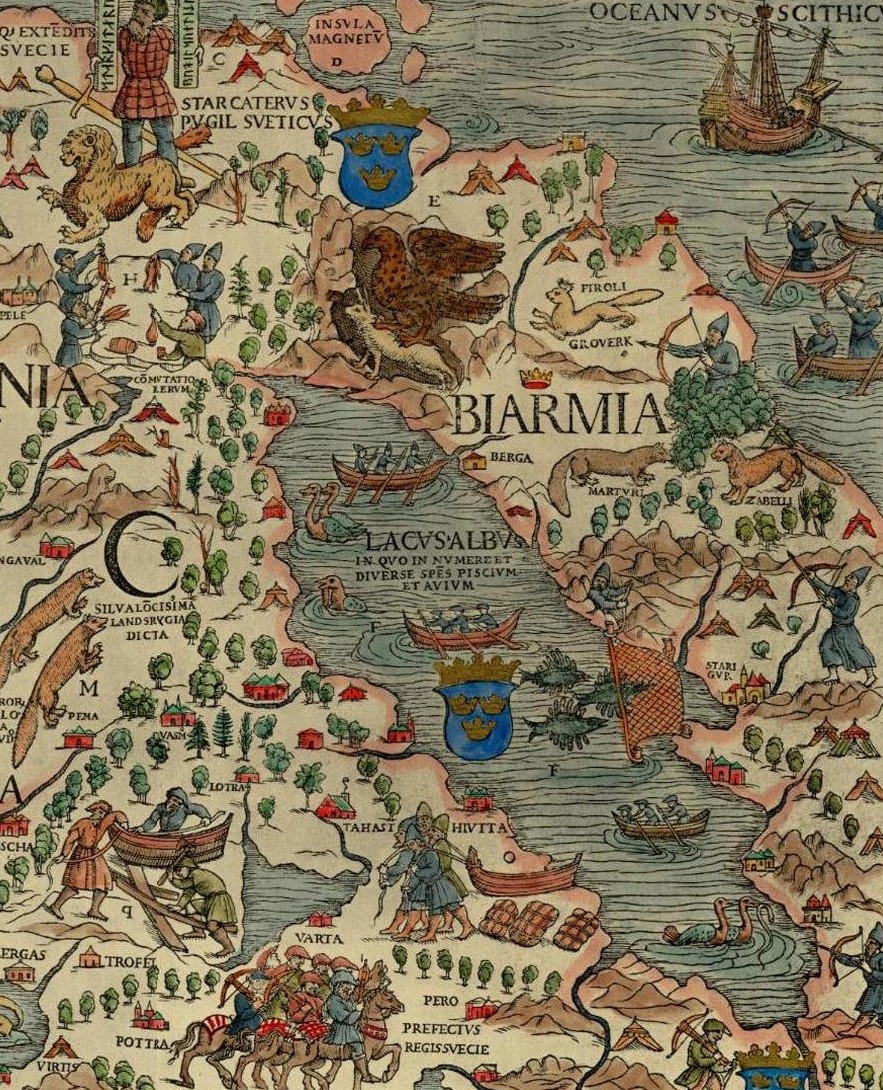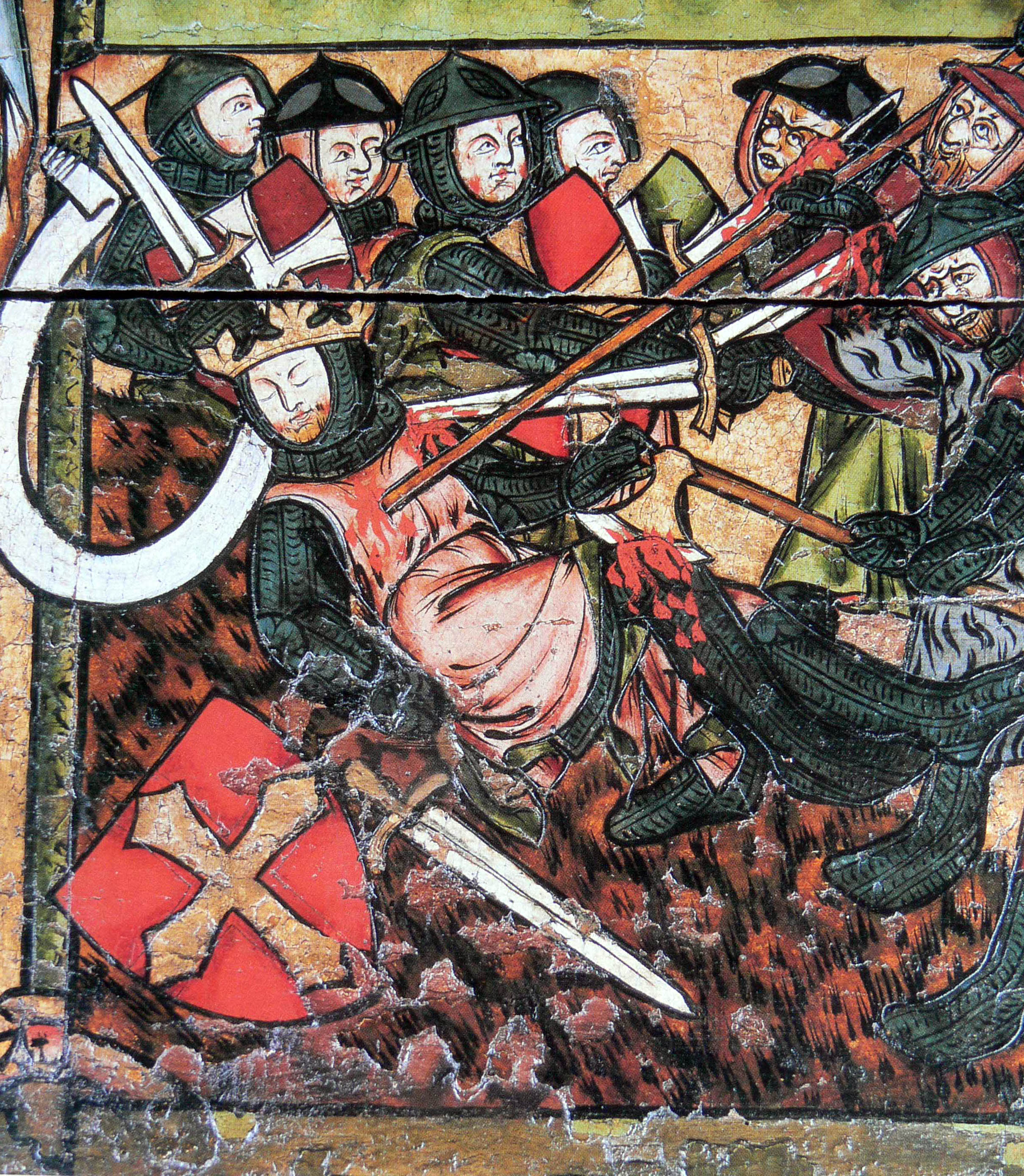|
Bjarmland
Bjarmaland (also spelt ''Bjarmland'' and ''Bjarmia''; Latin: ''Biarmia''; Old English: ''Beormaland,'' Komi: Биармия ''Biarmia,'' Old Permic: 𐍑𐍙𐍐𐍒𐍜𐍙𐍐) was a territory mentioned in Norse sagas since the Viking Age and in geographical accounts until the 16th century. The term is usually seen to have referred to the southern shores of the White Sea and the basin of the Northern Dvina River (''Vienanjoki'' in Finnish) as well as, presumably, some of the surrounding areas. Today, those territories comprise a part of the Arkhangelsk Oblast of Russia, as well as the Kola Peninsula. Norse voyagers in Bjarmaland According to the '' Voyage of Ohthere'' (c. 890 CE), the Norwegian merchant Ottar (Ohthere) reported to king Alfred the Great that he had sailed for 15 days along the northern coast and then southwards, finally arriving at a great river, probably the Northern Dvina. At the estuary of the river dwelt the ''Beormas'', who unlike the nom ... [...More Info...] [...Related Items...] OR: [Wikipedia] [Google] [Baidu] |
Nomadic
A nomad is a member of a community without fixed habitation who regularly moves to and from the same areas. Such groups include hunter-gatherers, pastoral nomads (owning livestock), tinkers and trader nomads. In the twentieth century, the population of nomadic pastoral tribes slowly decreased, reaching an estimated 30–40 million nomads in the world . Nomadic hunting and gathering—following seasonally available wild plants and game—is by far the oldest human subsistence method. Pastoralists raise herds of domesticated livestock, driving or accompanying them in patterns that normally avoid depleting pastures beyond their ability to recover. Nomadism is also a lifestyle adapted to infertile regions such as steppe, tundra, or ice and sand, where mobility is the most efficient strategy for exploiting scarce resources. For example, many groups living in the tundra are reindeer herders and are semi-nomadic, following forage for their animals. Sometimes also described as "nomad ... [...More Info...] [...Related Items...] OR: [Wikipedia] [Google] [Baidu] |
Samoyedic Peoples
The Samoyedic people (also Samodeic people)''Some ethnologists use the term 'Samodeic people' instead 'Samoyedic', see are a group of closely related peoples who speak Samoyedic languages, which are part of the Uralic family. They are a linguistic, ethnic, and cultural grouping. The name derives from the obsolete term ''Samoyed'' (meaning "self-eater" in Russian) used in Russia for some indigenous people of Siberia.'' e term Samoyedic is sometimes considered derogatory'' in Peoples Contemporary Extinct *Yurats, who spoke Yurats (Northern Samoyeds) * Mators or Motors, who spoke Mator (Southern Samoyeds) *Kamasins, who spoke Kamassian (Southern Samoyeds) (in the last census, two people identified still as Kamasin under the subgroup "other nationalities".)https://rosstat.gov.ru/free_doc/new_site/perepis2010/croc/Documents/Vol4/pub-04-02.pdf The largest of the Samoyedic peoples are the Nenets, who mainly live in two autonomous districts of Russia: Yamalo-Nenetsia and Nenetsia ... [...More Info...] [...Related Items...] OR: [Wikipedia] [Google] [Baidu] |
Nestor's Chronicle
The ''Tale of Bygone Years'' ( orv, Повѣсть времѧньныхъ лѣтъ, translit=Pověstĭ vremęnĭnyxŭ lětŭ; ; ; ; ), often known in English as the ''Rus' Primary Chronicle'', the ''Russian Primary Chronicle'', or simply the ''Primary Chronicle'', as well as also, after the author it has traditionally been ascribed to, '' Nestor's Chronicle'', is an Old East Slavic chronicle (letopis) of Kievan Rus' from about 850 to 1110, originally compiled in Kiev around 1113. The work’s name originates from the opening sentence of the text, which reads: “These are the narratives of bygone years regarding the origin of the land of Rus’ (Old East Slavic: Рѹсь), the first princes of Kyiv, and from what source the land of Rus’ had its beginning.” The work has long been considered to be a fundamental source in the interpretation of the history of the East Slavs. The ''Chronicle's'' content is known today from several surviving editions and codices that have been ... [...More Info...] [...Related Items...] OR: [Wikipedia] [Google] [Baidu] |
Rus' People
The Rusʹ (Old East Slavic: Рѹсь; Belarusian language, Belarusian, Russian language, Russian, Rusyn language, Rusyn, and Ukrainian language, Ukrainian: Русь; Old Norse: ''Garðaríki, Garðar''; Greek language, Greek: Ῥῶς, ''Rhos'') were a people in Early Middle Ages, early medieval eastern Europe. The scholarly consensus holds that they were originally Norsemen, mainly originating from present-day Sweden, who settled and ruled along Trade route from the Varangians to the Greeks, the river-routes between the Baltic and the Black Seas from around the 8th to 11th centuries AD. In the 9th century, they formed the state of Kievan Rusʹ, where the ruling Norsemen along with local Finnic peoples, Finnic tribes gradually assimilated into the East Slavs, East Slavic population, with Old East Slavic becoming the common spoken language. Old Norse language, Old Norse remained familiar to the elite until their complete assimilation by the second half of the 11th century, and i ... [...More Info...] [...Related Items...] OR: [Wikipedia] [Google] [Baidu] |
Permians
The Permians or Perm Finns are the peoples who speak Permic languages, in the Uralic language family, and include Komis and Udmurts. Formerly the name Bjarmians was also used to describe these peoples. Recent research on the Finno-Ugric substrate in northern Russian dialects suggests that in Bjarmaland there once lived speakers of other Finno-Ugric languages beside the Permians. The ancestors of the Permians originally inhabited the land called Permia covering the middle and upper Kama River. Permians split into two groups, probably during the 9th century. The Komis came under the rule of the Novgorod Republic in the 13th century and were converted to Orthodox Christianity in the 1360-1370s. In 1471-1478, their lands were conquered by the Grand Duchy of Moscow that later became the Tsardom of Russia. In the 18th century the Russian authorities opened the southern parts of the land to colonization and the northern parts became a place to which criminal and political prisoners were ... [...More Info...] [...Related Items...] OR: [Wikipedia] [Google] [Baidu] |
Ohthere Of Hålogaland
Ohthere of Hålogaland ( no, Ottar fra Hålogaland) was a Viking Age Norwegian seafarer known only from an account of his travels that he gave to King Alfred (r. 871–99) of the Anglo-Saxon kingdom of Wessex in about 890 AD. His account was incorporated into an Old English adaptation of a Latin historical book written early in the fifth century by Paulus Orosius, called ''Historiarum Adversum Paganos Libri VII'', or ''Seven Books of History Against the Pagans''. The Old English version of this book is believed to have been written in Wessex in King Alfred's lifetime or soon after his death, and the earliest surviving copy is attributed to the same place and time. In his account, Ohthere said that his home was in "Halgoland", or Hålogaland, where he lived "north-most of all Norwegians … inceno-one ivedto the north of him". Ohthere spoke of his travels north to the White Sea, and south to Denmark, describing both journeys in some detail. He also spoke of '' Sweoland ... [...More Info...] [...Related Items...] OR: [Wikipedia] [Google] [Baidu] |
Arkhangelsk
Arkhangelsk (, ; rus, Арха́нгельск, p=ɐrˈxanɡʲɪlʲsk), also known in English as Archangel and Archangelsk, is a types of inhabited localities in Russia, city and the administrative center of Arkhangelsk Oblast, Russia. It lies on both banks of the Northern Dvina near its mouth into the White Sea. The city spreads for over along the banks of the river and numerous islands of its river delta, delta. Arkhangelsk was the chief seaport of medieval and early modern Russia until 1703, when it was replaced by the newly-founded Saint Petersburg. A Northern Railway (Russia), railway runs from Arkhangelsk to Moscow via Vologda and Yaroslavl, and air travel is served by the Talagi Airport and the smaller Vaskovo Airport. As of the Russian Census (2021), 2021 Census, the city's population was 301,199. Coat of arms The arms of the city display the Michael (archangel), Archangel Michael in the act of defeating the Devil. Legend states that this victory took place near where ... [...More Info...] [...Related Items...] OR: [Wikipedia] [Google] [Baidu] |
Old Norse
Old Norse, Old Nordic, or Old Scandinavian, is a stage of development of North Germanic languages, North Germanic dialects before their final divergence into separate Nordic languages. Old Norse was spoken by inhabitants of Scandinavia and their Viking expansion, overseas settlements and chronologically coincides with the Viking Age, the Christianization of Scandinavia and the consolidation of Scandinavian kingdoms from about the 7th to the 15th centuries. The Proto-Norse language developed into Old Norse by the 8th century, and Old Norse began to develop into the modern North Germanic languages in the mid-to-late 14th century, ending the language phase known as Old Norse. These dates, however, are not absolute, since written Old Norse is found well into the 15th century. Old Norse was divided into three dialects: Old West Norse, ''Old West Norse'' or ''Old West Nordic'' (often referred to as ''Old Norse''), Old East Norse, ''Old East Norse'' or ''Old East Nordic'', and ''Ol ... [...More Info...] [...Related Items...] OR: [Wikipedia] [Google] [Baidu] |
Tore Hund
Modern and imaginary presentation of Tore Hund Thorir Hund (Old Norse: Þórir hundr, Modern Norwegian: ''Tore Hund'', literally "''Thorir the Hound''") (born ca. 990) was one of the greatest chiefs in Hålogaland. Tore Hund was one of the leaders of the Stiklestad peasant faction opposing Norwegian King Olaf II of Norway, later named St. Olaf. He was reported to have been among the chieftains who killed the king in the Battle of Stiklestad in 1030. He also served in the forces of King Canute the Great on several occasions."Tore Hund" '''' Background Thorir Hund was born at the beginning of the |
Haakon Magnusson Of Norway
Haakon Magnusson (Old Norse: ''Hákon Magnússon'', Norwegian: ''Håkon Magnusson''; 1068 – February 1095), byname Toresfostre (Old Norse: ''Þórisfóstra'', meaning "fostered by Tore"), was king of Norway from 1093 to 1095. Haakon was only partially recognized within Norway and his reign was thus of limited significance. He has generally not been counted in the numbered series of Norwegian kings. Life He was the grandson of King Harald Hardrada, son of King Magnus and nephew of King Olaf Kyrre. Haakon was born around the same time his father died. He was raised as a foster son by Tore på Steig of Gudbrandsdalen on the farm Steig in Fron. In 1090, he undertook a Viking expedition to Bjarmaland, today the area of Arkhangelsk in northern Russia. After the death of Olav Kyrre he was hailed as King of Norway in Trondheim, while his cousin, King Magnus Barefoot, was hailed in Viken. He soon came into conflict with King Magnus and war seemed inevitable. In 1095, Magnus Berrføtt ... [...More Info...] [...Related Items...] OR: [Wikipedia] [Google] [Baidu] |









